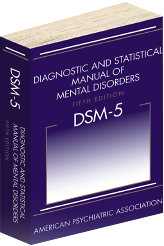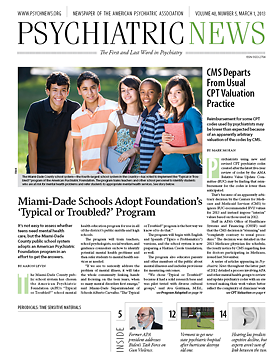A new chapter in DSM will bring together anxiety disorders that are preceded by a distressing or traumatic event.
Grouped into a chapter called “Trauma- and Stressor-Related Disorders” are several diagnoses that had appeared elsewhere in earlier editions of DSM: acute stress disorder, posttraumatic stress disorder (PTSD), adjustment disorder, and reactive attachment disorder.
“Trauma- and Stressor-Related Disorders” is followed by a new chapter that groups together dissociative disorders.
The two chapters are the seventh and eighth chapters to appear in Section II of DSM-5, which will be published in May; they appear in succession as part of a new organizational schema designed to link disorders that share common genetic or neurobiological substrates. The multiaxial system of previous editions has been eliminated, and chapters are now arranged according to a “lifespan” or developmental approach—disorders affecting children appearing first and those more common in older individuals appearing later.
Criteria Reflect Variability of Response
Matthew Friedman, M.D., Ph.D., chair of the Trauma, Stressor, and Dissociative Disorders Work Group, said several conceptual themes have guided the development of criteria for trauma- and stress-related disorders and the organization of the chapter. Criteria for both acute stress disorder and PTSD are now more explicit about how the distressing or traumatic event was experienced—directly experienced, witnessed, or experienced indirectly.
Criteria for both now reflect much research that has indicated the high degree of variability in how people initially react to distressing or traumatic events. “When PTSD was first proposed in 1980 for DSM-III, the major scientific model was that it was a fear-based anxiety disorder,” Friedman told Psychiatric News. “So the A2 criteria in DSM-IV called for a fear-based reaction of fear, helplessness, or horror. But a lot of research now indicates that for many people who have intense emotional reactions to a traumatic event and go on to develop PTSD, their reaction is not fear based, but more likely to be dysphoria or anhedonia.”
Moreover, some people who do develop PTSD report having no intense emotional reaction at all to the triggering phenomenon—especially those in professions that are trained to respond to traumatic events. “Marines or policemen will say, ‘My training kicked in; I just did my duty,’ ” Friedman told Psychiatric News. “And there has been a lot of good research showing that the A2 criteria in DSM-IV requiring a subjective response to the traumatic event has not been clinically helpful.
“So there have been patients who endorse all of the DSM-IV criteria for PTSD but don’t qualify for the diagnosis because they didn’t have this fear-based response,” Friedman said.
For acute stress disorder, Friedman said previous criteria requiring dissociative symptoms were too restrictive. Now, individuals may meet diagnostic criteria in DSM-5 for acute stress disorder if they exhibit any 9 of 14 listed symptoms in these categories: intrusion, negative mood, dissociation, avoidance, and arousal.
“So patients can have several symptoms of dissociation, or none at all,” he said.
Other PTSD Changes
There are significant changes to criteria for PTSD beyond the more-specific A1 criteria and the elimination of the requirement for a subjective response at the time of a traumatic event. There are now four symptom clusters in DSM-5 (as opposed to three in DSM-IV): re-experiencing, avoidance, persistent negative alterations in mood and cognition, and arousal.
Moreover, PTSD is now developmentally sensitive: diagnostic thresholds have been lowered and criteria have been modified for children age 6 or younger. (Criteria and thresholds for children older than 6 are essentially the same as for adults.)
Friedman said he believes the changes to the PTSD criteria are unlikely to affect epidemiology of the disorder, but if there is any effect, it will be to lower the prevalence slightly.
In other changes, the DSM-IV childhood diagnosis of “reactive attachment disorder” had two subtypes—emotionally withdrawn/inhibited and indiscriminately social/disinhibited—which in DSM-5 are now broken out into two distinct diagnoses: reactive attachment disorder and disinhibited social engagement disorder.
Finally, in DSM-IV, “adjustment disorder” had largely been used as a residual category for patients who didn’t meet criteria for other diagnoses. But in the revised manual, the disorder has been grouped with the trauma- and stress-related disorders.
“By moving adjustment disorder into this chapter, we hope to make it a more specific diagnosis reconceptualized as a stress-response syndrome following a traumatic or nontraumatic event,” Friedman said. “And we hope also to promote research on the variation in response to traumatic and nontraumatic events.”
Friedman added, “It’s a major change that we now have a chapter in DSM-5 specifically for diagnoses in which an adverse or traumatic event precedes the onset of symptoms.” ■
Additional information and audio clips of Friedman discussing “What is posttraumatic stress disorder?” and “Why is PTSD being grouped in a new category of DSM-5?” can be accessed at
http://www.psychiatry.org/dsm5.

